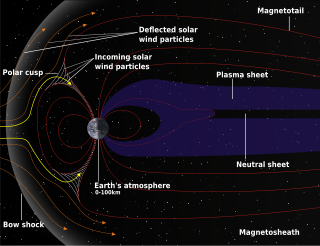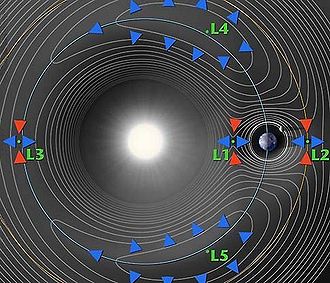- Lagrange point colonization
-
Space colonization Lagrange point colonization is the colonization of the five equilibrium points in the orbit of a planet or its primary moon, called Lagrange points. The most obvious points for colonization are the points in the Earth-Moon system and the points in the Sun-Earth system. Although it would generally take days or even months to reach with current technology, many of these points would have near-continuous solar power capability since their distance from Earth would result in only brief and infrequent eclipses of light from the Sun.
Contents
Earth-Moon
An L1 station would have a number of important functions due to its stationary position between the Earth and Moon. One, it is in a perfect location to monitor and coordinate communications among various missions on the nearside of the Moon. A vessel launched from L1 could reach any place on the Moon within a few hours to a day. This would make it ideal for crisis management if an emergency occurred on the Moon. Furthermore, it could serve as a way station, especially once built up, and would probably be used to handle tourists and casual visitors to the Moon. A station like this could also serve as a repair center for ships moving throughout the Solar System.
The L2 point, on the far side of the Moon, is completely shielded from the Earth by the Moon so radio telescopes placed there would receive much less interference than existing telescopes. Of course, since the moon is tide locked, any colony on the far side of the moon has this same benefit; a lunar facility, however, would suffer from "moonquakes".
Both L1 and L2 require active stationkeeping since neither is fully stable. Colonies at the L4 and L5 positions would have the advantage of being stable without any need for stationkeeping, and could be used as a waypoint for travel to and from cislunar space.
In addition, they would significantly reduce the delta-V (velocity change) needed to move from one to another, or to enter or leave Earth orbit, an important drawback of any Lunar surface station, which demands high energy expenditure to escape and comparable or greater amount to soft-land.
Sun-Earth
The L1 position is useful for solar observations since it is near the Earth but in constant sunlight. It could also be useful for collecting solar power. Conversely, the L2 point is perpetually in the shadow of the Earth, and as such offers a prime location for observing the outer planets or deep space. L4 and L5 colonies could be used as waypoints in space travel, to expand the practical launch window for travel to and from the Earth and other planets. These positions are useful for colonies as they are stable without any need for stationkeeping.
Disadvantages
 Schematic of Earth's magnetosphere. The solar wind flows from left to right.
Schematic of Earth's magnetosphere. The solar wind flows from left to right.
The risk of proton exposure from the solar wind as well as the health threat from cosmic rays is significant. In the Earth-Moon system, the orbit of colonies at L1 - L5 will take them outside of the protection of the Earth's magnetosphere for approximately two-thirds of the time (as occurs with the Moon). Colonies at L1 (located between the Earth and Moon) will experience this to a lesser degree while L2 (located beyond the Moon) will experience this to a greater degree and all of them will be exposed to the little understood plasma sheet of the magnetotail.[1]
In the Sun-Earth system, L1 and L3 - L5 are all outside of the protection of the Earth's magnetosphere. L2 periodically transfers from within the magnetotail, plasma sheet, and solar wind depending on the intensity and direction of the solar wind.
See also
References
Categories:
Wikimedia Foundation. 2010.

